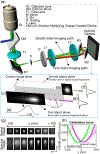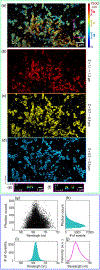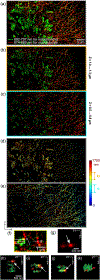Three-dimensional biplane spectroscopic single-molecule localization microscopy
- PMID: 36688951
- PMCID: PMC9854264
- DOI: 10.1364/optica.6.000709
Three-dimensional biplane spectroscopic single-molecule localization microscopy
Abstract
Spectroscopic single-molecule localization microscopy (sSMLM) captures the full emission spectra of individual molecules while simultaneously localizing their spatial locations at a precision greatly exceeding the optical diffraction limit. To achieve this, sSMLM uses a dispersive optical component to separate the emitted photons into dedicated spatial and spectral imaging channels for simultaneous acquisition. While adding a cylindrical lens in the spatial imaging channel enabled three-dimensional (3D) imaging in sSMLM, the inherent astigmatism leads to technical hurdles in spectral calibration and nonuniform lateral resolution at different depths. We found that implementing the biplane method based on the already established spatial and spectral imaging channels offers a much more attractive solution for 3D sSMLM. It allows for more efficient use of the limited photon budget and provides homogeneous lateral resolution compared with the astigmatism-based method using a cylindrical lens. Here we report 3D biplane sSMLM and demonstrate its multi-color 3D imaging capability by imaging microtubules and mitochondria in fixed COS-7 cells immunostained with Alexa Fluor 647 and CF 660C dyes, respectively. We showed a lateral localization precision of 20 nm at an average photon count of 550, a spectral precision of 4 nm at an average photon count of 1250, and an axial localization resolution of 50 nm.
Conflict of interest statement
Disclosures. C. Sun and H. F. Zhang have financial interests in Opticent Inc., which did not support this work. The other authors declare no conflicts of interest related to this work.
Figures




References
-
- Zhang Z, Kenny SJ, Hauser M, Li W, and Xu K, “Ultrahigh-throughput single-molecule spectroscopy and spectrally resolved super-resolution microscopy,” Nat. Methods 12, 935–938 (2015). - PubMed
-
- Dong B, Soetikno BT, Chen X, Backman V, Sun C, and Zhang HF,“Parallel three-dimensional tracking of quantum rods using polarization-sensitive spectroscopic photon localization microscopy,” ACS Photon. 4,1747–1752 (2017).
Grants and funding
LinkOut - more resources
Full Text Sources
Other Literature Sources
